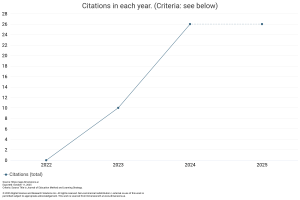Jigsaw Effects on Student Learning Outcomes: A Review
DOI:
https://doi.org/10.59653/jemls.v1i03.243Keywords:
learning methods, Jigsaw technique, student, creating schools, assessmentAbstract
Although cooperative learning strategies provide promise for creating schools that are welcoming to students of all backgrounds, they have not been generally adopted. The Jigsaw system is popular because it is thought to promote students' sociability and learning, and because it seems to be straightforward to apply and follow its four-step teaching framework. A comprehensive assessment of research that has investigated the effects of the Jigsaw method on crucial student educational outcomes was planned and carried out to ensure precise identification of the method's effects. After conducting inductive and deductive topic analyses on 10 Jigsaw studies, three key outcomes emerged: learning (including accomplishment and motivation), social relations, and self-esteem (including academic and social self-esteem). Jigsaw's effects on academic performance (n = 2), motivation (n = 1), social connections (n = 1), and self-perception in the classroom (n = 1) were quantified wherever feasible via supplementary reviews. With the exception of social self-esteem, for which only three studies concluded that the Jigsaw method had positive effects, the primary results of our review focused on the inconsistency of Jigsaw effects and the high degree of variability among studies with regard to all retained student educational outcomes (i.e., achievement, motivation, social relations, and academic self-esteem). Additionally, the findings were consistent across trials. Our analysis sheds light on a number of variables that may account for this variation in research, including sample size, student diversity, and curriculum. The moderating effects of these variables need empirical investigation since they may lead to more effective applications of the Jigsaw technique.
Downloads
References
Aronson, E., & Patnoe, S. (2011). Cooperation in the classroom: The jigsaw method. (No Title).
Bächtold, M., Roca, P., & De Checchi, K. (2023). Students’ beliefs and attitudes towards cooperative learning, and their relationship to motivation and approach to learning. Studies in Higher Education, 48(1). https://doi.org/10.1080/03075079.2022.2112028
Blajvaz, B. K., Bogdanović, I. Z., Jovanović, T. S., Stanisavljević, J. D., & Pavkov-Hrvojević, M. V. (2022). THE JIGSAW TECHNIQUE IN LOWER SECONDARY PHYSICS EDUCATION: STUDENTS’ ACHIEVEMENT, METACOGNITION AND MOTIVATION. Journal of Baltic Science Education, 21(4). https://doi.org/10.33225/jbse/22.21.545
Cochon Drouet, O., Lentillon-Kaestner, V., & Margas, N. (2023). Effects of the Jigsaw method on student educational outcomes: systematic review and meta-analyses. Frontiers in Psychology, 14. https://doi.org/10.3389/fpsyg.2023.1216437
Deci, E. L., & Ryan, R. M. (2000). The" what" and" why" of goal pursuits: Human needs and the self-determination of behavior. Psychological Inquiry, 11(4), 227–268.
Hesjedal, E., Hetland, H., Iversen, A. C., & Manger, T. (2015). Interprofessional collaboration as a means of including children at risk: An analysis of Norwegian educational policy documents. International Journal of Inclusive Education, 19(12). https://doi.org/10.1080/13603116.2015.1057241
Melinamani, S., Francis, F., George, R., Pushpa, L. M., & Vergheese, S. (2017). The Jigsaw effect: Impact of Jigsaw learning technique on nursing students to learn the concepts of normal labor. Asian Journal of Nursing Education and Research, 7(2). https://doi.org/10.5958/2349-2996.2017.00037.4
Millis, B. J. (2023). Why Faculty Should Adopt Cooperative Learning Approaches. In Cooperative Learning in Higher Education. https://doi.org/10.4324/9781003443681-1
Moher, D., Liberati, A., Tetzlaff, J., Altman, D. G., Altman, D., Antes, G., Atkins, D., Barbour, V., Barrowman, N., Berlin, J. A., Clark, J., Clarke, M., Cook, D., D’Amico, R., Deeks, J. J., Devereaux, P. J., Dickersin, K., Egger, M., Ernst, E., … Tugwell, P. (2009). Preferred reporting items for systematic reviews and meta-analyses: The PRISMA statement. PLoS Medicine, 6(7). https://doi.org/10.1371/journal.pmed.1000097
Phuntsho, S., & Gyeltshen, T. (2022). Effectiveness of jigsaw cooperative learning approach in mathematics: A study in a middle secondary school in Bumthang district. Interdisciplinary Journal of Applied and Basics …, 2(May).
Roseth, C. J., Lee, Y., & Saltarelli, W. A. (2019). Reconsidering jigsaw social psychology: Longitudinal effects on social interdependence, sociocognitive conflict regulation, motivation, and achievement. Journal of Educational Psychology, 111(1), 149.
Safkolam, R., Zaky El Islami, R. A., & Sari, I. J. (2023). The Effects of Jigsaw Technique on Learning Achievement and Retention of Science Teacher Students. Shanlax International Journal of Education, 11(2). https://doi.org/10.34293/education.v11i2.5959
Stanczak, A. (2020). La méthode de la" classe puzzle" est-elle efficace pour améliorer l’apprentissage? Université Clermont Auvergne [2017-2020].
Ural, E., Ercan, O., & Gençoğlan, D. M. (2017). The effect of jigsaw technique on 6th graders’ learning of force and motion unit and their science attitudes and motivation. Asia-Pacific Forum on Science Learning and Teaching, 18(1).
Vakilifard, A., Bahramlou, K., & Mousavian, M. (2020). The effect of cooperative learning approach and semantic mapping strategy on the acquisition of L2 Persian vocabulary. Cogent Education, 7(1). https://doi.org/10.1080/2331186X.2020.1762287
Downloads
Published
How to Cite
Issue
Section
License
Copyright (c) 2023 Sugeng Mashudi, Siti Mubayinah

This work is licensed under a Creative Commons Attribution-ShareAlike 4.0 International License.
Authors who publish with this journal agree to the following terms:
- Authors retain copyright and grant the journal right of first publication with the work simultaneously licensed under a Creative Commons Attribution-ShareAlike that allows others to share the work with an acknowledgement of the work's authorship and initial publication in this journal.
- Authors are able to enter into separate, additional contractual arrangements for the non-exclusive distribution of the journal's published version of the work (e.g., post it to an institutional repository or publish it in a book), with an acknowledgement of its initial publication in this journal.
- Authors are permitted and encouraged to post their work online (e.g., in institutional repositories or on their website) prior to and during the submission process, as it can lead to productive exchanges, as well as earlier and greater citation of published work (See The Effect of Open Access).
























